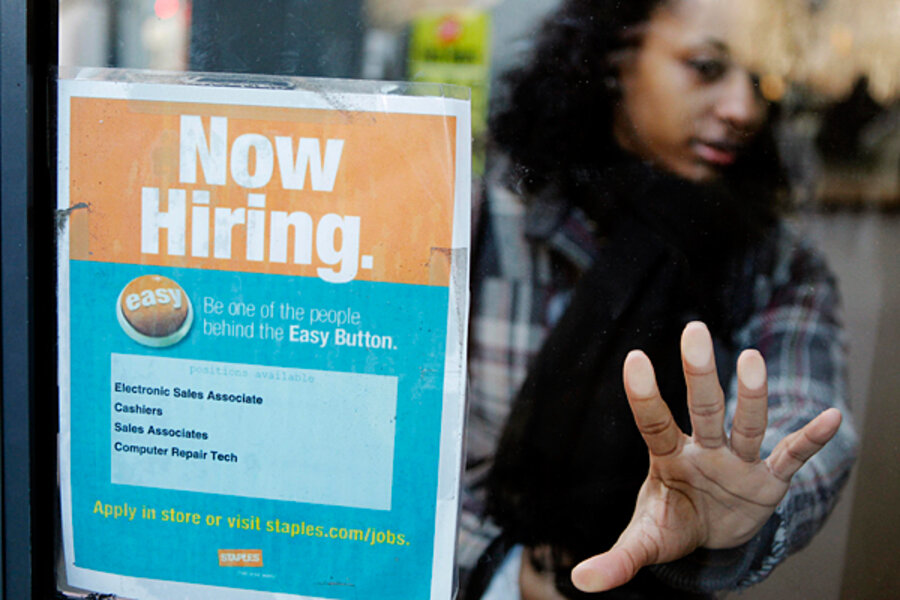Unemployment rate drops to 8.9 percent. Has the economy turned a corner?
Loading...
| New York
Without the impediment of mountains of snow last month, businesses started to hire workers.
The economy added 192,000 jobs in February, the best showing since May of last year, the Bureau of Labor Statistics reported Friday. The politically important unemployment rate fell from 9 percent to 8.9 percent.
Economists viewed the employment numbers as “solid” but not “ebullient.” The numbers were a marked improvement over January, when 63,000 jobs were created. (That figure is from a revised report.)
But it’s not clear yet if job creation has reached the point where it is self-sustaining – that is, where the increasing number of workers increases demand for goods and services, resulting in yet more demand for workers.
The optimists believe the economy has turned the corner. “I think the economy has not only turned the corner: I am expecting the employment gains to accelerate slightly,” says Sung Won Sohn, a professor of finance at California State University, Channel Islands. “We have definitely reached the point where the economy is self-sustaining.”
This would mean that the Federal Reserve could stop its monetary stimulus program for the economy, says Mr. Sohn, former chief economist for Wells Fargo Bank. “There is a growing possibility they will cut short their bond-buying program before the end of June,” he says.
Better job growth would also help reduce the federal budget deficit, since income-tax revenues would increase and less unemployment benefits would be needed. States and cities could get a boost for the same reasons.
“The chances are the revenue projections may be slightly better than the government anticipates,” Sohn says.
However, other economists say it is too soon to say the economy is self-sustaining.
“If we see 200,000 jobs added in March, April, and May, that will convince market participants that the recovery is self-sustaining,” says John Canally, economist at LPL Financial in Boston. “You can’t make that call just by looking at February, because the numbers may have been distorted by the weather.”
According to Mr. Canally, the clearest indications of how the weather affected the numbers were in construction, which gained 22,000 jobs in February after dropping 33,000 in January; the transportation sector, which added 22,000 jobs compared with losing 44,000 in January; and leisure and hospitality, which added 21,000 jobs after dropping 3,000 the prior month.
“All of those swings are because of the weather,” he says.
Other sectors had more jobs last month, too. Manufacturing added 33,000 jobs, mostly in the production of durable goods such as washing machines and refrigerators.
This is not a surprise to Frank Fantozzi, president of Planned Financial Services in Cleveland. It counts among its clients 65 corporate ones.
“In talking to our corporate clients, we were hearing there was definitely hiring going on and activity improving,” says Mr. Fantozzi. “My litmus test is when our corporate clients from manufacturing to services send me e-mails saying they are looking to hire someone and asking if we have anyone in our network who would qualify.”
The Obama administration took credit for the job gains, while still noting that the unemployment rate remains too high.
“We are seeing signs the initiatives put in place by this Administration – such as the payroll tax cut and the investment tax credit – are creating the conditions for sustained growth and job creation,” said Austan Goolsbee, chairman of the Council of Economic Advisers, in a statement.
However, Republicans said the improvement was because they had pressured the Obama administration into extending the Bush-era tax cuts for another two years.
“Removing the uncertainty caused by those looming tax hikes provided much-needed relief for private-sector job creators in America,” said House Speaker John Boehner in a statement.
No matter who can take the credit, some labor-market participants say they are seeing a lot of interest in hiring. This is particularly the case for the temporary-help industry, which added 15,500 jobs last month.
“Hiring is picking up, no doubt about that,” says Roy Krause, CEO of SFN Group in Fort Lauderdale, Fla. The company is one of the largest temp agencies.
The first wave of hiring involved industrial and manufacturing companies, Mr. Krause says. Now, he is seeing a demand for accounting and finance professionals, as well as IT professionals who can help companies move to tablet computers or integrate Microsoft’s Windows 7 operating system into their workforce.
The one cloud on the horizon, says Krause, is the rising price of gasoline. He says he was recently in a small Kentucky town where a company wanted to begin hiring workers. But it was hard to find enough workers who could afford to drive 40 to 50 miles at the wages being offered.
“They just won’t do it,” he says, predicting, “We’re going to see some wage inflation, especially at the low end of the labor spectrum.”





